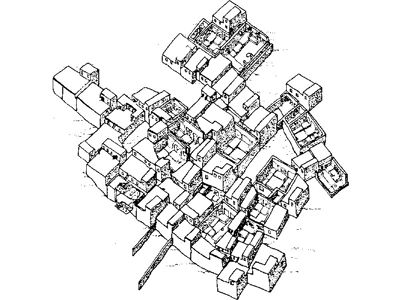
To finish up with closed systems, let’s take a quick look at Catalhoyuk, one of the earliest cities. Catalhoyuk was also the subject of the oldest known map, and the image of the city in this slide comes from an article on this page: The Town Plan of Catalhoyuk.
Catalhoyuk was founded in about 7,500 BC, or thereabouts (I’ve read different estimates), in what is now Turkey. It was one of the very earliest cities. For comparison, the Sumerian city of Ur, from which we get ‘urban’, wasn’t founded until 4,000 BC.
To give a bit of background, Catalhoyuk had a population of up to 10,000 people, and a few strange features like a religion that appears to have been based on fear (‘aren’t they all?’ said someone in the room). To me, the most interesting bit is that the houses were all squashed together. No streets!
To get to your house, you had to climb up on top of the city, walk along until you got to your chimney and climb down. You’d live in your couple of rooms, and bury your dead under the floor. Every so often, you’d knock the house down and build another on top of the rubble. And so the hive-mound rose up.
But no streets is what gets me. That streets – gaps between buildings – are an invention—it’s a beautiful concept. Of course streets had to be invented at some point (Ur had them), but Catalhoyuk reminds us so brilliantly. I imagine it felt like some kind of science fiction architecture at the time: Imagine if related houses were somehow kept close together, they’d say, so you could quickly get between them, and there were faster routes across our whole city!
Would Discovery, Le Guin’s generation ship, feel like Catalhoyuk, or like something else? Sometimes the web feels claustrophobic, like Catalhoyuk may have done.
The Wikipedia article on Catalhoyuk is worth a read, and I collect more links about it.